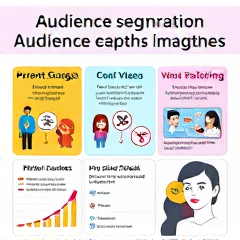Review of the book "Marketing of Educational Services" by Evgeniya Kuzmina. About promotion in the field of education
The author doesn't stand on ceremony: she provides dry statistics — many applicants choose a university based on activity and reviews on TikTok, and their parents are willing to pay above market rate if the school runs an honest blog and publishes real case studies of graduates.
While reading, you can't help but nod in agreement — yes, that's how it is, we see all this around us, but few people honestly admit that standard promotional templates in education are outdated, and new tools require not only a budget but also the courage to go against the tide.
The book grabs you with its cheeky tone and the fact that the author is not afraid to call things by their name, making you wonder: haven't we ourselves gotten stuck in the past when we think about education marketing?
Key Concepts and Their Analysis

Instead of vague reasoning about "branding" and "content", Kuzmina immediately lays out the key cards:
- Mechanisms for building trust
- Digital touchpoints with parents
- Real scenarios for retaining students within the funnel
From the first click on a story to signing a contract in the reception. The book has no room for vague advice.
Kuzmina doesn't get abstract — she analyzes not only the tools but also their limitations:
- Aggressive targeting leads to a outflow of "warm" leads
- Too frequent mailings cause irritation among the audience, up to unsubscribes
Delving into these details, you catch yourself thinking — the author is like lancing the abscesses of the industry's pain points, not letting the reader hide behind excuses.
Who is the book for
The book is addressed to those who cannot afford the luxury of learning "from mistakes" in conditions of fierce competition:
- school principals
- online course managers
- marketers of educational startups
- those who are just thinking of leaving a corporate office to start their own "alma mater"
There is no room for safe theories just for the sake of it - the material is designed for those who face harsh reality daily:
- conversion rate drops
- the cunning of parent chats
- seasonal dips in applications
If you're used to cozy infographics and general advice, this book will take you out of your comfort zone: instead of "universal" tips, you'll find step-by-step algorithms for anti-crisis actions, screenshots of real auto funnels, tables with A/B test results, rather than SMM "magic."
It feels like the author is writing for those who work 24/7, who care not about academic pomp, but about results - even if they're expressed in customer churn figures month by month. Not glossy marketing tales, but a honest post-mortem analysis for pragmatists who are tired of hearing about "values" and just want to understand how to pull their project out of stagnation.
About the author and their significance in marketing

Not many people in the market have expertise that inspires not only respect but also healthy surprise: Evgenia Kuzmina is one of them. Behind her is not only a decade of promoting real educational projects from Moscow private schools to online universities in the regions, but also an impressive list of failures, which she is not afraid to reveal in her book - with specific figures on budget losses, retention drops, and frank descriptions of failed strategies.
It's nice that instead of the usual self-admiration and quoting of one's own credentials, the reader gets the nervous pulse of real-life experience:
- Kuzmina doesn't get lost in theoretical clouds.
- She writes as if she's sitting at the next table in the meeting room.
- Her voice is truly weighty in the professional community.
No wonder she's invited to consult not only startups but also federal networks - she has a rare quality in the market: the ability to look at numbers without illusions and to admit mistakes as thoroughly as successes.
The Place of the Book in Modern Marketing Literature
Against the backdrop of faceless manuals and collections of secondary analytics churned out by marketing centers, Kuzmina's work stands out almost provocatively: it doesn't try to appeal to everyone at once, doesn't get carried away with abstractions, and doesn't sell another universal pill "for everyone and everything". Here, we have the real market — with its rough edges, nerves, and dirty hands, not a sterile laboratory of hypotheses.
Over the past two years, I haven't come across another work that so frankly outlines not only growth schemes but also real losses, and whose paragraphs don't drown in banal advice like "create unique content" or "build a personal brand".
It's precisely this that has carved out a separate niche for the book: it doesn't pretend to be another encyclopedia but becomes a workbook for those who are willing to see cracks in the facade and aren't afraid to learn from others' mistakes without blowing them out of proportion.
On the shelf between traditional gurus from business schools and trendy "info-gypsies" from TikTok, this work is like a breath of fresh air: concrete facts, a human tone, and, most importantly, an absence of illusions, of which there are already more than enough in the industry.
| Aspect | Kuzmina's Book | Traditional Approaches |
|---|---|---|
| Approach | Practical | Theoretical |
| Discussion of Losses | Yes | No |
| Advice | Specific | General |
Relevance of the publication at the moment

Today, when the educational market is shaken by changes more often than our news feed, such publications are more of a rarity than a rule. The author doesn't dwell on the eternal truths, but hits where it hurts right now:
- Pandemic
- Mass transition to online
- Devaluation of diplomas
- Fight for user attention
In 2023, only in Russia, the online education market grew by 31%, and along with it, the competition became fierce. In these conditions, the book shows how to survive not on paper, but in real conditions, where:
- The institution doesn't have a million-dollar budget
- Students go to bloggers for "quick knowledge"
Everything written here works not in an ideal world, but here and now - for those who don't seek salvation in moldy theories, but try to find working tools in the midst of chaos.
Fundamental Marketing Concepts

Instead of self-soothing rituals like the classic "4P", here they put all their cards on the table, with raw, unvarnished facts:
- Demand
- Supply
- Value
- Positioning
Not as an abstraction, but as the daily routine of any course director trying to squeeze the last pennies out of their budget. Kuzmin doesn't waste time on soothing tales of a "dream brand", but instead dissects basic principles like a surgeon with a scalpel:
Product — is not a set of hours, but an experience that a student will want not just to buy, but to recommend to friends (as confirmed by a survey where 57% of new students come through recommendations, not advertising).
Pricing policy? A separate headache: the author doesn't hesitate to discuss the devaluation of courses due to discount inflation and openly writes that "cheap" isn't always selling.
Promotion channels are considered not through the lens of a marketer's dreams, but with specificity:
- How much does a lead from "VKontakte" cost versus targeted advertising on TikTok
- Who really comes from Telegram channels, and who are just random passersby.
The book doesn't present its ideas as unshakeable truths, but rather invites the reader to evaluate and apply them to their own experience. This makes reading an active process, where you understand that success depends not on magic, but on hard work and practical skills.
Innovative ideas and modern trends
But this is where Kuzmina's text really gets to the heart of the matter - in the section on new trends: there's not a grain of nonsense about "breakthrough technologies" or "metaverses", but with surgical precision, it reveals the working mechanics that are already turning the familiar market landscape on its head today.
- Kuzmina is not afraid to admit: automation is not a magic wand, but a headache that requires weekly adjustments (a table is provided: maintaining CRM takes an average of 14 hours per month for an average project).
- Special emphasis is placed on new channels: the author shows with numbers how "smart" mailings in messengers outpace classic email chains in conversion by almost twice , and attempts to drive traffic through public channels often end in budget drain.
There's no room for rose-colored glasses here - just bare numbers, concrete schemes, and real-life cases, and because of this, the book turns from an old-fashioned textbook into a step-by-step plan for those who really want not just to "be on trend", but to survive and grow in conditions where every decision costs money and reputation.
Applicability of concepts in modern business
In the practical field, where theory is usually broken by harsh reality, a rare book can boast that its advice does not sink into the swamp of abstractions — and this is where Kuzmina's text pleasantly surprises: every concept is as if tested on its own back, meticulously broken down into details, adapted to the realities of the domestic market.
When it comes to the implementation of short training formats, the author is not limited to a cheerful slogan — she provides figures for the growth of repeat purchases on specific platforms, announces real return percentages (not the average temperature in the hospital) and honestly describes the pitfalls that managers face in the field.
Especially striking is the frankness regarding costs — when maintaining automated processes takes not a mythical hour a month, but a full-fledged two work shifts, you involuntarily start to believe every word.
The reader is left with no illusions: to get a return, you have to work hard, count, test, and not rely on a beautiful wrapper. With this approach, the material does not gather dust on the shelf, but turns into a working tool that you want to try out in your project right away — and if you make mistakes, then at least on someone else's rake, not because of "vacuum" advice.
| Parameter | Kuzmina's Book | Other Books |
|---|---|---|
| Market Adaptation | ||
| Concrete Data | ||
| Honesty in Costs | ||
| Practical Application |
Case studies and examples from real business
One of the key advantages of the book is its reliance on real case studies from the Russian market. Evgenia Kuzmina not only describes working approaches but also shows how they worked (or didn't work) in real projects: from Moscow private schools to regional online universities.
In one of the examples, where an educational company decides to launch modular courses and instead of the expected boom faces a drop in conversion, Kuzmina doesn't hush up the failure, but meticulously describes the specific steps taken to adjust the strategy:
- changes to the landing page
- revision of the bonus system for teachers
This approach inspires respect - it doesn't try to embellish the picture, but honestly shows that "there are no miracles", and even the most fashionable tools require daily painstaking work.
In the end, the reader gets not a set of rose-colored mirages, but a set of real scenarios - with all their rough edges, numbers, losses, and small triumphs, which may not make it into textbooks, but will definitely be useful to those who are not afraid to learn from others' experience.
Strengths of the publication
Without false modesty, one of the trump cards of this book is its genuine practicality: there is no room for abstractions and verbal juggling here — every thesis is immediately supported by vivid, and sometimes painfully accurate details from real processes.
- The author consistently brings to light not only winning cases, but also those where the strategy cracked.
- Instead of covering up inconvenient facts, Kuzmina step by step untangles the knot of mistakes.
- Explaining how hypotheses were tested, what mistakes managers made, and why there was no "magic pill".
This is not just inspiring, but also instills confidence: if even recognized experts make mistakes, it means that the path of trial and error is part of any dynamically developing company.
Such an honest approach disarms skeptics and becomes a breath of fresh air for those who are used to seeing only a showcase of success without the wrong side in professional literature.
Critical Analysis
However, it is worth noting the pitfalls — despite the transparency of analyzing mistakes, sometimes the author gets too carried away with listing particular cases, forgetting to build a coherent picture from them.
- On one of the pages, where the failure of the partnership program for universities is analyzed, the analysis gets stuck on the emotions of managers and the details of correspondence.
- The reader would be much more interested in seeing in-depth analytics:
- Why the calculation failed,
- What alternatives were considered,
- How it affected the long-term strategy.
- In such moments, you want to shake up the text and ask: “Where are the conclusions?” — because it is precisely for systematicity and structure that we turn to business literature.
- Yes, honesty is captivating, but sometimes frankness turns into a stream of observations, from which the reader has to sift out the grains themselves.
So, if you are looking for rigid algorithms and ready-made schemes, be prepared for the fact that you will have to figure out for yourself how to apply these rakes to your own yard.
Tools and techniques for practical use
What really catches your eye — the toolkit here is not served on a silver platter, but rather hinted at and implied, as if the author deliberately avoids direct instructions.
- The section devoted to developing a funnel for attracting students through social media leaves a mixed impression
On the one hand, there are several interesting moves outlined, on the other — it all looks like a set of disparate life hacks. If you have no experience in the education business, you risk getting bogged down in the details and not taking away anything systemic.
But if you like to collect techniques bit by bit, filtering others' mistakes and successful findings, then this is a feast: each solution, like a trophy from different eras, requires independent restoration and adaptation to the realities of your project.
It's best to leave hopes for universal recipes at the door — but there's a chance to catch a living thought, extract something of your own from it, and perhaps be surprised at how non-obvious solutions sometimes turn out to be effective.
Popularity of the current publication

Evgenia Kuzmina's book quickly found a response from the professional community: marketers in the field of education, heads of private schools, EdTech entrepreneurs and online course producers. It is discussed in specialized Telegram channels, quoted at industry conferences, and used as a working manual when launching or restarting educational products.
- The book was included in the "recommended reading" lists from several major EdTech companies;
- Received positive reviews on professional platforms and social networks;
- Used as additional literature on courses on educational marketing.
This hype is explained not so much by the uniqueness of the solutions, but by the obvious lack of clear and modern domestic guides for those who work at the intersection of education and business. Although the book won't become a bible for everyone, it is discussed and referenced, and, more importantly, the author manages to engage the audience in a dialogue, rather than just pushing another "methodological guide with pictures".
Other works by the author
If we look at the previous works of Kuzmina, it immediately becomes apparent that each of her projects is an attempt to grasp the elusive essence of changes in education, whether it's:
- a review of online courses in 2020;
- a resonant article about digital student profiles that caused a stir in the professional community.
Unlike her fresh book, her «Marketing Planning», released earlier with a modest print run of 800 copies, went almost unnoticed by the general public:
- there are just over a dozen reviews on «Goodreads»;
- discussions in professional groups got lost in a series of similar posts.
However, a narrow circle of experts still recalls the laconic checklists and unexpectedly sharp questions that Kuzmina raised in that edition. It seems that the author is consistently looking not just for a new word, but for working mechanisms for those who are immersed in the modern educational chaos — and, judging by the dynamics of interest, is reaching a wider audience with each attempt, balancing between academic snobbery and practical common sense.
Comparison with other works by the author
Unlike last year's work, written as if for internal use by narrow professional circles, Kuzmina's new book surprises with the scale of its ambitions — it shows a clear desire to go beyond the usual walls and speak to those who don't live on conferences and don't read industry digests before bed.
If back then the author cautiously added fuel to the fire of professional discussions, now she's wielding a poker:
- The number of practical tools has almost tripled (compared to the previous 47 items on the checklist — here are 130 detailed recommendations and templates)
- The language has become sharper, even provocative in places
All this resembles an evolution from behind-the-scenes experiments to a public declaration of leadership on the topic — and, to be honest, this turn cannot but command respect, even if it sometimes makes one wince at the excessive categoricalness of the formulations.
| Criterion | Old book | New book |
|---|---|---|
| Number of tools | 47 | 130 |
| Language style | Cautious | Sharp and provocative |
Similar literature by other authors
Against the background of this sudden openness and immodest abundance of applied findings, it is hard not to recall such heavyweights as:
- Digital pedagogy. A practical course by Marina Safonova on digital transformations in educational projects
- "Education as a product" by Ekaterina Lapshina. The author considers educational programs as a full-fledged product that requires packaging, positioning, and continuous improvement.
However, they do this with delicate academic restraint, as if fearing to offend someone's corporate interests.
Unlike them, Kuzmina not only doesn't hesitate to speak her mind, but also deliberately takes the reader away from standard templates, offering sometimes controversial but always concrete solutions.
Moreover, if Safonova's work contains at most three or four cases diluted with statistics, here every third paragraph claims to be exclusive:
- Analysis of the failure of a regional college on TikTok
- A detailed guide on launching an online course from scratch
In this sense, comparing with colleagues in the field, the new book is more like not a textbook, but a detailed report from the battlefield — and this is able not only to irritate, but also to win over with its merciless honesty.
